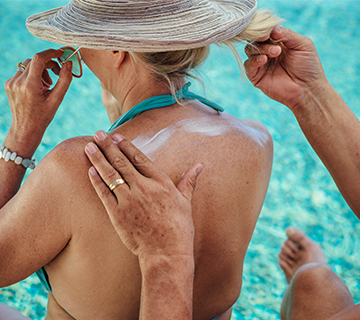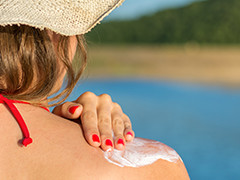Common Myths of Sunshine & Sunscreen

Think you know everything there is to staying safe in the sun? Test your knowledge by reading up on the truth behind common sun exposure myths.
MYTH: You don’t need sunscreen on cloudy days.
Truth is, even if it’s overcast you should be wearing sunscreen. UV rays can be harmful to any exposed area throughout the day.
MYTH: You won’t get vitamin D if you wear sunscreen.
Sunscreen blocks UV rays, which means that in theory it would block the essential sunshine-derived vitamin D. However, sunlight can still make its way through clothing. Plus, sunscreen loses its effectiveness over time. So even after 5 to 30 minutes in the sun, you’ll still get enough vitamin D.
MYTH: Sunscreen is bad for you.
Oxybenzone, an active ingredient in many sunscreens, was once attributed to negative side effects in rats. However, after 40 years of research, studies have shown that exposure to oxybenzone through normal sunscreen use is safe.
MYTH: Darker skin tones don’t need sunscreen.
Melanin does diffuse UVB rays, but UVA damage is still possible. Be sure to use a full-spectrum sunscreen to prevent sunburn and skin damage.
MYTH: Base tans protect your skin.
According to Harvard Medical School, getting a base tan from lying in a tanning bed is only equivalent to wearing sunscreen with an SPF of 3 to 4. That might seem helpful, but tanning beds only use UVA light to darken skin. The very little protection from a temporary tan won’t shield from sunburns caused by UVB light. You’ll need a full-spectrum sunscreen to keep yourself protected.
MYTH: Makeup protects the face.
Many brands offer makeup with SPF included in the ingredients. However, makeup fades throughout the day, particularly in warmer weather. Always apply a layer of sunscreen before makeup, so that you’re not just relying on your foundation for protection.
MYTH: Wearing sunscreen is better than covering up.
Unfortunately, slathering on sunscreen isn’t a one-and-done barrier to the sun. Since it needs to be reapplied to stay effective, wear wide brimmed hats or stay in the shade to reduce skin exposure to the sun.
MYTH: Sunscreen stops you from tanning.
Sure, sunscreen protects from most light rays, but the sun will still manage to reach your skin. Tanning is the body’s natural reaction to UV exposure, so unless you completely cover up and reapply sunscreen religiously, you’ll still get some color.
MYTH: All sunscreens do the same thing.
Different sunscreens protect against different levels of sun exposure. When choosing a sunscreen, look for “full-spectrum” on the label. This will help protect your skin against the largest range of UV light. The FDA also recommends using an SPF of at least 15 for adequate protection.
MYTH: Sunscreen lasts all day and never expires.
Sunscreen contains active ingredients that break down over time, which means that it naturally expires. And even though a product might say that its sweat-proof or water-resistant, no sunscreen is actually 100% waterproof. Take time to reapply every 2 to 4 hours, and let it soak in for at least 15 minutes before going in water.


